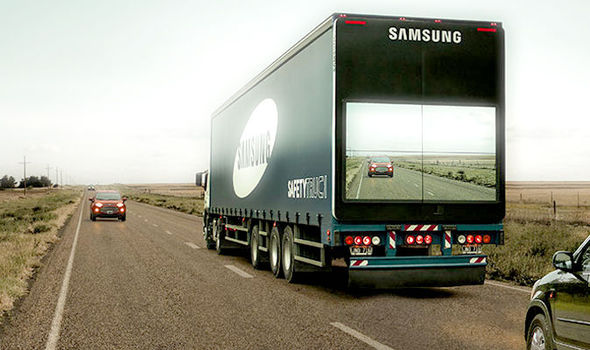
Transparentius
Samsung Argentina acaba de proponer este año una tecnología para ayudar a la seguridad vial llamada “Samsung Safety Truck”, que consiste en poner pantallas en las partes traseras de los camiones y una cámara en su frente, para que la gente pueda ver en la pantalla lo que el camión le tapa de su visibilidad a la hora de rebasarlo. Es decir, la gente podría ver en la pantallas si viene coche o no el sentido contrario. Aquí hay un video del mismo.
A pesar de las “buenas intenciones” que podría aparentar tener una campaña así, la idea suena un poco descabellada, difícil de implementar y en algunos casos, hasta de mayor riesgo para los conductores (hacerlos confiar mas por lo que ven en una pantalla, en lugar de tener los ojos en el camino real). Además de verse un poco truculenta (a nivel publicidad) por ser liberada justo en tiempo de premios y festivales de publicidad internacionales; hablo de Cannes, claro. O sea, tiene toda la cara de ser un “trucho” (una campaña creada solo para ganar premios).
Pero lo peor no es eso. Parece que a la gente se le olvida que internet está lleno de información y es muy fácil rastrear el origen de las cosas. Existe un despacho de diseño en Rusia, que desde 2009 ya proponía este recurso tecnológico como una solución de seguridad vial. El proyecto se llama “Transparentius”, y estaba a cargo del artista e ingeniero industrial/gráfico/ambiental Artemy Lebedeb. Me parece que la idea se abandonó por presentar algunas inconsistencias y riesgos no resueltos al llevarse la práctica.
Por más que quise encontrar créditos, referencias, una mención o por lo menos un “hat tip” para este sitio y/o proyecto, no encontré nada. Así que, ni utilidad real, ni seguridad real, ni innovación tecnológica, ni credibilidad como campaña, ni tantita vergüenza hacia el hecho de estar usando las ideas originales de otras personas. Todo mal, Samsung.
Pronto más noticias sobre el descarado mundo de la publicidad…
Trucks on highways often appear to be an obstacle for other drivers wishing to pass or change lanes. Transparentius road view transmitting system would allow them to see what’s in the blind zone before switching lanes.
The video signal is delivered from the camera mounted in the head of the truck to the back door panels through a projector. Transparentius would make driving easier and safer both during the day and at night…

